From the Editor... The Next Hill
Fan Mail...
Passage: Lydudmila Bogoslovskaya
Inuit Dogs Indigenous Heritage Confirmed!
Pangaggujjiniq Nunavut Quest 2015
British Explorers Dogged by Myths
Making of The Savage Innocents
Paving over Cultural Identity Update
In the News...
Bannock: The Movie!
Media Review... Never Alone
IMHO... It Ain't Easy
Navigating This Site
Index of articles by subject
Index of back issues by volume number
Search The Fan Hitch
Articles to download and print
Ordering Ken MacRury's Thesis
Our comprehensive list of resources
Defining the Inuit Dog
Talk to The Fan Hitch
The Fan Hitch home page
Editor: Sue Hamilton
Webmaster: Mark Hamilton
The Fan Hitch, Journal
of the Inuit Sled Dog, is published four
times a year. It is available at no cost
online at: https://thefanhitch.org.
The Fan Hitch welcomes your letters, stories, comments and suggestions. The editorial staff reserves the right to edit submissions used for publication.
Contents of The Fan Hitch are protected by international copyright laws. No photo, drawing or text may be reproduced in any form without written consent. Webmasters please note: written consent is necessary before linking this site to yours! Please forward requests to Sue Hamilton, 55 Town Line Rd., Harwinton, Connecticut 06791, USA or mail@thefanhitch.org.
This site is dedicated to the Inuit Dog as well as related Inuit culture and traditions. It is also home to The Fan Hitch, Journal of the Inuit Sled Dog.
The Fan Hitch welcomes your letters, stories, comments and suggestions. The editorial staff reserves the right to edit submissions used for publication.
Contents of The Fan Hitch are protected by international copyright laws. No photo, drawing or text may be reproduced in any form without written consent. Webmasters please note: written consent is necessary before linking this site to yours! Please forward requests to Sue Hamilton, 55 Town Line Rd., Harwinton, Connecticut 06791, USA or mail@thefanhitch.org.
This site is dedicated to the Inuit Dog as well as related Inuit culture and traditions. It is also home to The Fan Hitch, Journal of the Inuit Sled Dog.
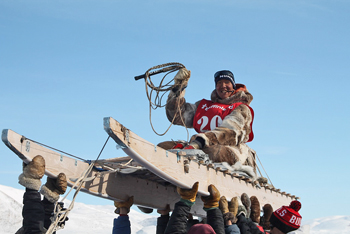
Jonah Qaunaq used all traditional skin harnesses, leads, and clothing
during the race. Here he is held up at the finish, as all racers are,
celebrating his 4th place, complete with cigar. photo: S. Gearheard
Pangaggujjiniq Nunavut Quest 2015
by Shari Fox Gearheard
Sitting in the tent I can hear the kids outside playing – “Ai ai ai! Uuuua! Uuuua!” – a few of the kids act as the sled dogs, pulling one of their friends on a mini-qamutiik (sled) made just for his 4-5 year old size. The little musher yells out the commands and cracks a pretend whip made from a stick and piece of light plastic rope, delighted as he gets pulled around in the snow. This goes on most nights at camp during the Nunavut Quest dog sled race. Racers, support crews, officials and even the kids are totally engrossed in the culture of Inuit dogs and dog teaming for the time we are out on this wonderful event.
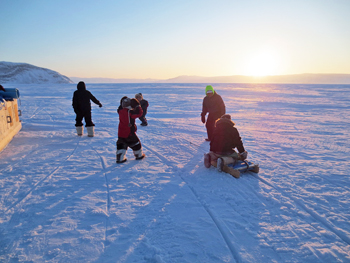
Kids play dog team during evenings at camp. photo: S. Gearheard
The 2015 Nunavut Quest, a roughly 400 kilometer (250 mile) celebration of all things qimmiit, started in Pond Inlet on April 23rd and finished in Arctic Bay seven days later. This was its 16th annual run, which began in 1999 to mark the creation of Nunavut and to celebrate the Inuit tradition of dog teaming.
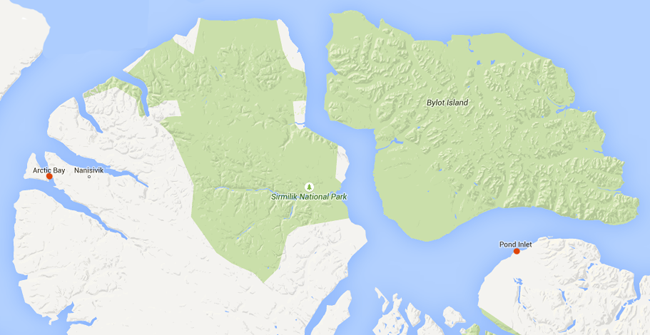
Bylot and the top of Baffin Island in the Canadian High Arctic. Google Maps
The Nunavut Quest entrants have daily start (they are released one minute apart, timed by the official race timekeeper) and finish lines between the ultimate starting and ending communities. Racers are timed each day and the overall fastest time wins. There is also a system for applying and deducting minutes for things like dropping/picking up items on the trail, or helping other teams, which keeps it interesting too! Each dog team has a support crew, usually family and friends, driving at least one snowmachine per team and towing all the supplies needed for travel, camping and eating (dogs included) out on the land. The support crews start each day first, leaving an hour before the dog teams. A local Elder or expert hunter leads the support crew convoy as they set off for the end of the day’s camp, traveling roughly 80 km (50 miles) each day. There is no official pre-determined race map or written route. A general route is discussed and maps are consulted, but the knowledge of the race leaders and Elders, weather, traditional campsites, ice conditions and other factors dictate the exact daily route and locations to rest for each night. Daily mushers’ meetings review the previous day and provide needed information for the day to come. Mushers rely on their land skills and close relationship with their dogs to help them follow the convoy and find the camps. Sometimes the convoy follows well-traveled local routes and other times they may break new trail. If the weather is calm, the trail of all the snowmachines is easy to follow, but if there is heavy wind, blowing snow, or areas of bare ice, dogs and their drivers need to work together to navigate.
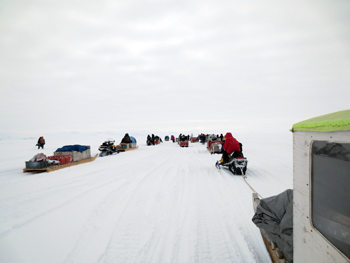
Convoy of race support crews heads out for the day.
photo: S. Gearheard
The list of official rules says that all dogs must be Canadian Inuit Dogs. No Siberian Huskies or Alaska racing dogs are allowed. This is a race for working sledge dogs, not sprinters. All equipment (harnesses, traces, sleds, etc.) must be handmade and dogs must be run in the traditional fan hitch style. It is a race that emphasizes and showcases traditional Inuit knowledge, traditional Inuit dog teaming skills and values, and the strong working relationship between a musher and his or her Inuit dogs.
The 2015 race had all the hallmarks of the Nunavut Quest – a challenging route, beautiful scenery, exchange of culture and knowledge amongst the participants, sharing of stories and food, lots and lots of dog talk, and of course a little bad weather and snowmachine breakdowns thrown in there too. Every year’s Quest is different and the 2015 race had its own share of special stories.
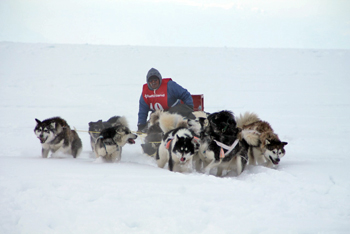
Seasoned Nunavut Quest racer Moses Uyukuluk from Arctic Bay
brings his team through the deep soft snow to camp 1.
photo: S. Gearheard
Always unique to each Quest are the conditions. This year the weather was calm and clear for the most part, except one very windy day that even blew some snowmachines and their qamutiit (easily up to 1000 pounds loaded with fuel and other supplies) sideways across glare ice. And deep, soft snow made for some hard working days and tested the fitness of dogs and drivers alike. Temperatures were above minus 10C (14F), warmer than usual, so some dogs got a bit warm during the daytime. The route was over both sea ice and land with some big hills to climb and descend.
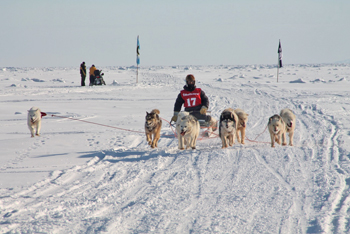
Overall 1st place finisher Amosie Sivugat from Clyde River crosses
a check point at the end of the day. photo: S. Gearheard
One standout story was the great racing of first place winner Amosie Sivugat from Clyde River. Amosie came in first place on day one and stayed in that position for the rest of the race, except for the very last day when a few other teams were finally able to edge past him. Amosie, an experienced hunter who uses his dogs regularly at home for travel and hunting, held the fastest cumulative time and took home the $15,000 prize and many congratulations from his fellow qimuksiqtiit.
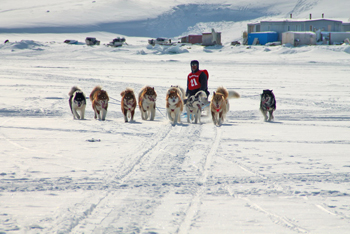
Jake Gearheard from Clyde River arriving at the finish in Arctic Bay.
photo: S. Gearheard
Amosie was followed up by second place finisher Jake Gearheard, also from Clyde River, and Michael Inuarak from Pond Inlet who placed third. Twelve racers in total participated, from four different communities. Several of the racers were well-seasoned Nunavut Questers, like Moses Uyukuluk and Olayuq Barnabas, both from Arctic Bay. But a number of racers like Inuarak and his brother Lee, Jonah Qaunaq, Michael Qaunaq and Joey Aqqiaruq from Igloolik, are young – young in years, but all experienced and very passionate about Inuit dogs and the traditions and practice of dog teaming. Their energy and commitment to Inuit dog team culture was evident throughout the race and gave no doubt that this event, as well as Inuit traditions of dog teaming itself, will be alive and well in Nunavut for a long time to come.
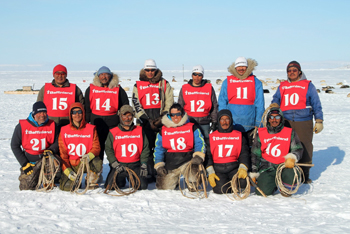
2015 Nunavut Quest racers: Back row from left: Titus Alooloo (Pond Inlet/PI), Olayuq Barnabas (Arctic Bay/AB), Lee Inuarak (PI), Michael Qaunaq (Igloolik/IG), Joey Aqqiaruq (IG), Moses Uyukuluk (AB). Front row from left: Jake Gearheard (Clyde River/CR), Jonah Qaunaq (IG), Jason Palluq (CR), Michael Inuarak (PI), Amosie Sivugat (CR), Teeman Avingaq (AB)
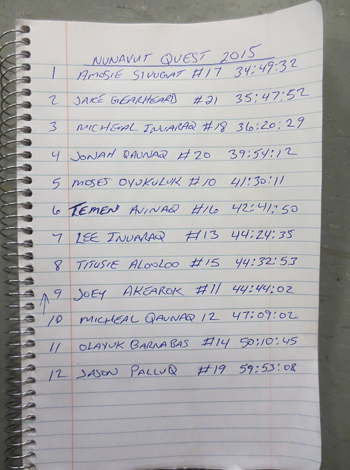
The official finishing times of the 2015 Nunavut Quest;
timekeeper Norman Pauloosie. photo: S. Gearheard
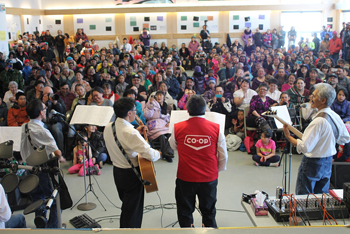
Arctic Bay sure knows how to throw a party! The band plays during
the awards ceremony and closing celebrations of the 2015 Nunavut Quest.
photo: S. Gearheard
Shari and her husband Jake live in Clyde River, Nunavut, with their team of 18 Inuit sled dogs. They have participated in five Nunavut Quest races.